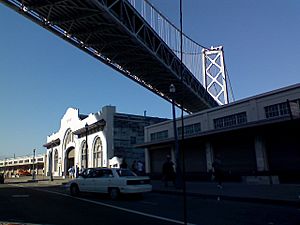Pier 26 (San Francisco, California) facts for kids
Pier 26 is a historic building in San Francisco, California. It's located right on the Embarcadero, a famous waterfront street, and sits under the huge San Francisco–Oakland Bay Bridge. This pier is a large wooden building that rests partly on land and partly on poles in the bay. It's about 100,000 square feet, which is a lot of space! Today, Pier 26 is mostly used for parking and storage. Its front part, facing the Embarcadero, is very important because of its history.
Contents
History of Pier 26
In the mid-1800s, after the California Gold Rush, San Francisco's waterfront was a mess. Many people who came to find gold simply left their ships behind. In 1863, a group called The Board of State Harbor Commissioners decided to build a strong wall along the bay shore. This wall is now known as the Embarcadero.
Pier 26 was built from older piers and docks in its current spot. After the big earthquake and fire of 1906, many piers were rebuilt and made more modern. The Port of San Francisco then started using a system of numbered piers. Odd-numbered piers were north of the Ferry Building, and even-numbered piers were to the south. Pier 26 was rented out to a shipping company for many years. However, by the 1950s, the port wasn't used for commercial shipping much anymore. Today, most big ships go to the Port of Oakland across the bay.
The 1934 Waterfront Strike

In 1934, a big event called the 1934 West Coast Waterfront Strike happened. Workers who loaded and unloaded ships, called longshoremen, organized their unions at Pier 26. On July 5, 1934, a sad day known as "Bloody Thursday" occurred. During protests outside Pier 26, two union workers died.
Even though some people thought the strike didn't fully succeed, it helped the longshoremen get a much-needed pay raise. This was during the Great Depression, a very tough economic time. The strike also made the waterfront unions stronger in their fight against unfair treatment. To remember "Bloody Thursday," the International Longshore and Warehouse Union does not work on July 5 each year.
Pier 26 During World War II
The piers along the San Francisco waterfront were very important during World War II, especially for the war in the Pacific. When the war started, San Francisco's waterfront became a major center for moving military supplies. Troops, equipment, and supplies left the Port of San Francisco to support the war effort. Almost every pier and dock was used for military activities. Troop ships and navy vessels were tied up all along the Embarcadero. For a short time from 1941 to 1942, the military even placed antiaircraft guns and searchlights at piers along the waterfront.
Shelton Studios at Pier 26
In 2006, a group called Shelton Studios leased the historic Pier 26 building. They started using it for film and theater projects. Shelton Studios was founded by Jean Shelton and Robert Elross, who were well-known in the Bay Area's theater and film world. Today, a photo of Jean Shelton from 1947 is displayed in the main window of Pier 26.


